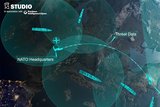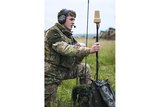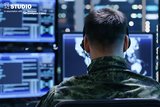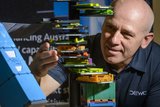Making sense of the data through satellite ground systems (Studio)
Brought to you in partnership with Raytheon Intelligence & Space
To exploit the vast output of space-borne data at their fingertips, militaries rely on satellite ground systems.
Raytheon Intelligence & Space (RIS) is pursuing a range of innovations in the domain, enhancing the systems and speeding their time to market.
For militaries today, data is ‘coming at a rate of speed like we’ve never seen before’, according to Karen Casey.
Casey is chief engineer for RIS’s Future Operationally Resilient Ground Evolution (FORGE) Mission Data Processing Application Framework (MDPAF), a satellite ground system.
This data is multiplied across a greater number of sensors and satellites than ever before, she noted.
‘You need to be able to take mountains of data and find that needle in the haystack,’ Casey explained.
Ground system specialists such as RIS embrace these mountains of data, Casey said, appreciating the opportunities it provides for military operators.
Developing satellite ground systems is a complex process, she said, focused not just on equipment, ‘but on all of those piece parts, algorithms, technologies, and user interface displays that make meaning out of data’.
While satellite data has long been recognised as a key enabler for the US and its allies, this is increasingly true in the modern battlespace, with an increasing focus on multi-domain operations (MDO) and international interoperability.
Such concepts have grown in importance against the backdrop of rising peer and regional competitors.

The US pioneered early space development, from airborne imagery to communications, but ‘as more nations participate and launch their own capabilities, it enables a larger coalition of space missions … coordination is key’, Casey noted.
This international dimension brings two significant challenges, Casey said. First, there is the technological challenge of sharing data and tasking across various boundaries, both political and geographical.
There is also a major policy implication, she said, centred on ‘how different nations put in place the policy to be able to work together, to do targeting together, to do tasking together, to work together on a common mission’.
Each has a different policy for data sharing, for instance, along with their own national space policies and a range of legal considerations around launch, ground and space operations.
The impetus towards interoperability is being driven at both an industrial and a governmental level, said Christy Cox, a Program Director at RIS who leads the defence giant’s Allied Solutions portfolio.
Each nation – and its manufacturers – has its own specific capabilities, but ‘the sum is greater than each of its parts’, whether that be analytics, ground assets, or space-based sensors.
‘Whether it’s disaster response or a military operation, we’re always going in with our partners.’
The sheer volume of data is fuelling technological advances, with Cox pointing to the evolution of automation and artificial intelligence/machine learning (AI/ML) capabilities. This is essential to ‘submit meaningful information to the user’, she added.
To keep pace with these developments, RIS is investing in its Digital Engineering capabilities, notably the development of digital twins, a software-based model of a component or a system used in technical development and manufacturing.
Using the analogy of building a car, Casey said that digital twins allow manufactures to capture essential characteristics:
‘It’s not stacks of paper that define the specifications for the tire or the wheel – it’s truly a digital twin that describes the behaviours of the car.’

In the development of satellite ground systems, this enables Raytheon to identify a range of potential challenges, both technological and in the manufacturing process: anticipating bottlenecks, for example.
‘This is fundamentally different to how we’ve architected, engineered and designed systems in the past, when it was stovepipes of teams… it was a very laborious process.’
Such innovations have crucial military implications, ensuring operators receive the equipment and capabilities they need as quickly as possible.
Raytheon can now deliver new satellite ground systems in a matter of months, Casey said, a process that previously could take two years. Part of this comes from a new approach to sourcing technology and ideas, across the company and beyond, including commercial off the shelf (COTS), she explained.
The human factor is also key, Casey stressed, with RIS seeking innovations in how it builds its teams.
‘We bring in so much diversity of opinion and thought,’ Casey said. ‘My job is technology – I still put the people part of this and that diversity of thought far ahead of any piece of technology that we work with on our programme.’
Prototyping is a good example of this evolution, Cox said, with Raytheon now ‘willing to fail a little bit faster, willing to do experiments and demos that we wouldn’t have before’, an approach that has brought dividends in the satellite ground systems space.
A higher appetite for risk and failure is an ideal environment for sharpening a team’s skills, particularly if these specialists eventually transition to a more mission-critical programme.
‘It's very fast-paced, and it's a great way to bring in new talent to Raytheon,’ Cox said.
More from Space Solutions Special Report
-
![Delivering Space Solutions - the Crucial Layer for Missile Defence (video)]()
Delivering Space Solutions - the Crucial Layer for Missile Defence (video)
Against the backdrop of rising ‘peer’ and regional state rivals, the role of space-based assets for effective missile defence will be critical.
-
![Why space-based assets are crucial for effective missile defence (Studio)]()
Why space-based assets are crucial for effective missile defence (Studio)
Adding a space layer to missile defence is not an optional extra – it is crucial.
-
![British Army embraces SlingShot]()
British Army embraces SlingShot
Add-on kit turns UHF/VHF radio into a BLoS solution to support voice and data communications.
-
![Delivering Space Solutions - the New Digital Engineering Paradigm (video)]()
Delivering Space Solutions - the New Digital Engineering Paradigm (video)
Digital engineering is transforming the defence industry, from design to manufacturing.
-
![Digital engineering: a new era of manufacturing (Studio)]()
Digital engineering: a new era of manufacturing (Studio)
The digital engineering concept creates an environment where a single, digital source of truth empowers defence manufacturing.
-
![DEWC Systems takes MOESS sensor development to next stage]()
DEWC Systems takes MOESS sensor development to next stage
The MOESS programme intends to deploy a sovereign Australian tactical electromagnetic sensor capability, installed on a constellation of CubeSats. DEWC is developing a sensor that can conduct radar electronic support in defence-relevant radio frequency bands used by assets such as ships and aircraft.

























